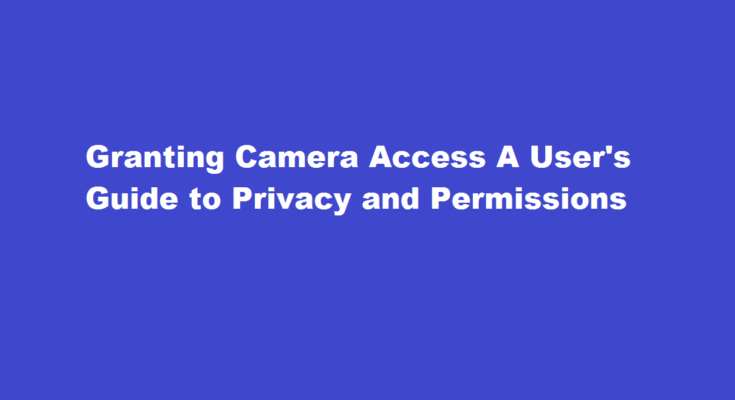Introduction
In today’s digital age, granting camera access to various applications and services has become commonplace. However, ensuring your privacy and security while using your device’s camera is crucial. This article aims to provide you with a comprehensive guide on granting camera permissions, empowering you to make informed decisions and protect your privacy.
Understanding Camera Permissions
Camera permissions are the authorizations granted to applications or services to access your device’s camera. It allows them to capture photos or videos and utilize them for their intended functionality. These permissions are essential for applications such as video calling, photography, augmented reality, and barcode scanning. Nevertheless, it is vital to approach camera permissions cautiously, as improper use could compromise your privacy or lead to unauthorized access to your personal data.
Prioritize App Legitimacy
When granting camera access, it is crucial to prioritize the legitimacy of the app or service requesting permission. Stick to reputable sources such as official app stores, and carefully review user feedback and ratings. Research the app developer and ensure their track record demonstrates a commitment to user privacy and security. Additionally, always read the app’s privacy policy and terms of service to understand how they handle your camera data. Only grant camera access to apps you trust.
Assess App Permissions
Before granting camera access, thoroughly evaluate the permissions an app requests. Some apps may require access to your camera for their core functionality, while others may have unnecessary camera permissions. Consider if the requested access aligns with the app’s intended purpose. If an app’s permission requests seem excessive or unrelated, exercise caution and reconsider granting access. On Android devices, you can review and manage permissions in the settings, while iOS devices prompt permission requests when an app requires access to your camera.
Managing Camera Permissions
To manage camera permissions effectively, regularly review and reassess the apps that have access to your camera. Revoking camera access for apps you no longer use or trust is crucial. On both Android and iOS devices, you can adjust app permissions in the settings. For example, on Android, navigate to “Settings > Apps & notifications > App permissions > Camera” to control camera access for individual apps. On iOS, visit “Settings > Privacy > Camera” to manage app permissions. Consider enabling notifications for permission requests to stay informed about any unexpected access attempts.
Strengthening Device Security
Apart from managing app permissions, it’s essential to strengthen your device’s overall security. Regularly update your operating system and apps to ensure you have the latest security patches. Install a reputable mobile security app that provides additional layers of protection against malware and unauthorized access. Consider using strong, unique passwords or biometric authentication methods to secure your device. Being proactive in device security minimizes the risk of unauthorized access to your camera and personal data.
FREQUENTLY ASKED QUESTIONS
What is camera permission?
The first time you hit this, the app will ask permission to access your camera. If you say No, then the app simply can’t use that functionality. You can change permission settings for apps on Android by going to Settings > Apps > See all X apps.
What are camera settings?
Three of the most important settings are shutter speed, ISO, and aperture — otherwise known as the exposure triangle, or the three pillars of photography. Shutter speed: As its name suggests, shutter speed is how quickly the shutter closes. A fast shutter speed lets in less light, while a slower one lets in more.
What is important in camera?
Aperture, shutter speed, and ISO settings are the three most important camera settings when it comes to exposure: “Camera lens and aperture” captured by Nayu Kim. 1. Aperture is the size of the opening of the lens through which light enters to expose the shot.
Conclusion
Granting camera access is an everyday occurrence, but maintaining control over permissions is vital for safeguarding your privacy. By prioritizing app legitimacy, evaluating permissions, and managing access effectively, you can confidently utilize your device’s camera while keeping your personal data secure. Remember, informed decision-making and regular review of camera permissions are key to maintaining control over your digital privacy.
Read Also : Unlocking The Power of Google Drive Ensuring Access for All



